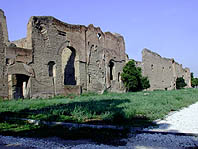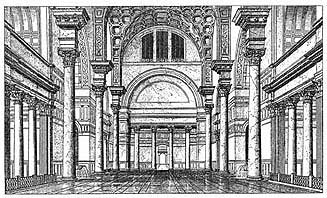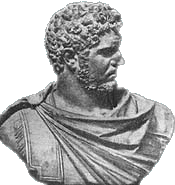Circus Maximus and Baths of Caracalla
Baths of Caracalla
 Emperor Caracalla built this enormous complex of Baths in 212 - 217 AD to curry favor with the Romans. "Bathing" was a way of life. Everybody, even the slaves, had the right to partake of the Baths, with room for 1,600 bathers at the same time.
Emperor Caracalla built this enormous complex of Baths in 212 - 217 AD to curry favor with the Romans. "Bathing" was a way of life. Everybody, even the slaves, had the right to partake of the Baths, with room for 1,600 bathers at the same time.
Hot baths, tepid baths and an unheated swimming pool with a masseur standing by to rub your skin with essential oils. Also 2 "palestrae", or gyms, where ball games and wrestling took place; light snacks and drink vendors; two libraries, Greek and Latin, where one could study books written on scrolls (books as we know them were invented in the Renaissance), the "paper" being papyrus parchment or goat skin (pergamon).
You could stroll in the gardens or sit under a tree and review the world (or discuss who gave the best party last night). All the arts were on parade: theater, sculpture, painting, music, and particularly mosaic (of which some examples are to be seen here today).
Hours, under most Emperors, were compartmentalized: men in the mornings, women in the afternoons, and slaves between 4 and 6 pm. The place itself was so beautiful, one felt rejuvenated and refreshed with all that self-indulgence.
When Mussolini started the performances of Grand Opera in these glorious ruins in the 1930s on warm summer nights, the Baths lived again. He would be driven by underground passage to a point right below his box, and would appear magically in his seat at the start of the show.
For under these baths, as in many Roman ruins, there is a vast infrastructure of "cryptoportici", or subterranean passages. In those caves enormous quantities of wood were stocked for the fires which burned day and night to heat the water coming in continually through the aqueducts.
Sadly, in the last few years these musical evenings stopped. No longer can you see the famous super productions of "Aida", with elephants and dromedaries enlivening the stage. When the sopranos hit high C, archeologists shuddered as they felt the walls, like glass, were being shattered by the sound waves.
But music is returning to the baths in the summer, so watch the newspapers for announcements.
 Description of the interior. Soon after you enter on the south side of the 330 square yard gardens, go into the great building on your left. Here you cross diagonally one of the "palestrae" (large gyms) with a circular niche in front of you. Then pass through the "tepidarium" (warm baths) and notice the circular "calidarium" (hot bath) on your left.
Description of the interior. Soon after you enter on the south side of the 330 square yard gardens, go into the great building on your left. Here you cross diagonally one of the "palestrae" (large gyms) with a circular niche in front of you. Then pass through the "tepidarium" (warm baths) and notice the circular "calidarium" (hot bath) on your left.
Keep your eyes roving for spotting large tracts of mosaics that once covered the floors.
You end up at the other gym and can come back to see the "frigidarium" (cold swimming pool) which was just beyond the soaring ruins of vast arches to your left.
Here it was that the strains of Aida would float out on a summer's night on a stage between the arches; and camels and elephants would pad and clatter up the ramp. A small "apodyteria" (changing room) was on either side of the cold pool.
| Baths of Caracalla History
|
Viale delle Terme di Caracalla (Map K 10)
 212 AD. Caracalla commenced the building.
212 AD. Caracalla commenced the building.